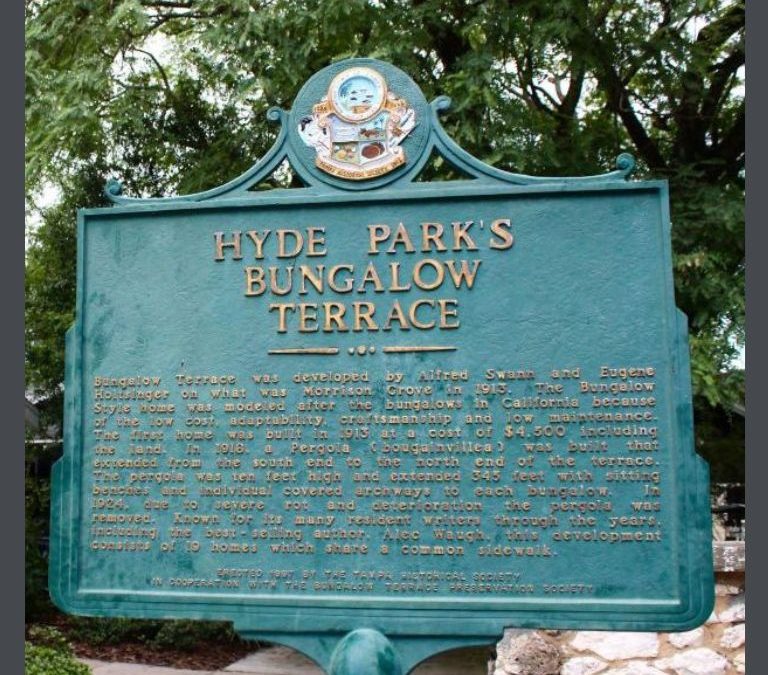
by bungalow101 | Mar 30, 2023 | Features, Places to visit
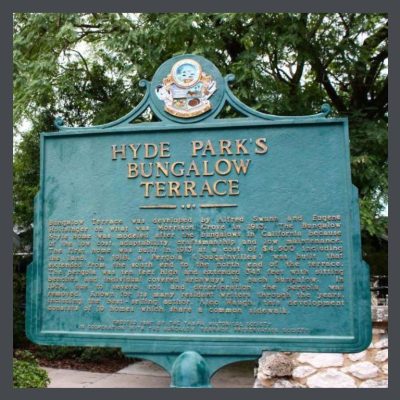 INSCRIPTION:
INSCRIPTION:
“Bungalow Terrace [in Hyde Park, Tampa, Florida] was developed by Alfred Swann and Eugene Holtsinger [major developers in South Tampa] on what was Morrison Grove in 1913. The Bungalow Style home was modeled after the bungalows in California because of the low cost, adaptability, craftsmanship and low maintenance.
The first home was built in 1913 at a cost of $4,500 including the land. In 1916, a Pergola (bougainvillea) was built that extended from the south end to the north end of the terrace. The pergola was ten feet high and extended 345 feet with sitting benches and individual covered archways to each bungalow. In 1924, due to severe rot and deterioration the pergola was removed. Known for its many resident writers through the year including the best-selling author, Alec Waugh, this development consists of 19 homes which share a common sidewalk.”
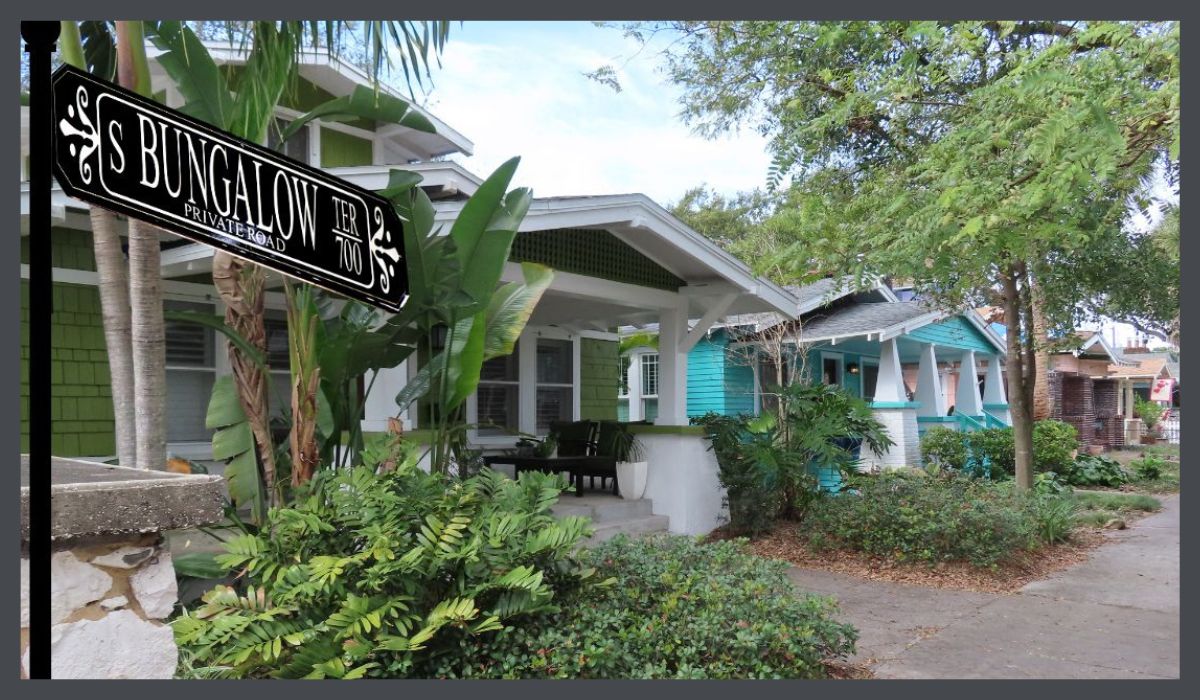
ENTERING THE COURT
So, here I am on a balmy winter day, getting ready to enter Hyde Park’s Bungalow Terrace.
My first adventure into a bungalow court was visiting an interior designer, specializing in Arts & Crafts, in L.A. Her little house was a mini-me of my bungalow, inside & out. It was fascinating. I was never able to learn who the architect of my house, was, nor for the court. I’m still kinda upset by it.
Bungalow courts originated in Pasadena California, & their intelligent, aesthetic & practical design motivated Pasadena’s City Council to require that all multi-family units be built around a landscaped courtyard. Great idea! And an idea easy to import to Florida, another state enjoying massive growth & needing housing. A brilliant model, developers today would be wise to mimic it to solve today’s housing shortage & to satisfy people’s need for green space & for community.
This court is in South Tampa, Florida in the neighborhood of Hyde Park. It covers a whole suburban block. Platted in 1916, the first residents began moving in in 1920. The variety of architecture featured is totally charming.
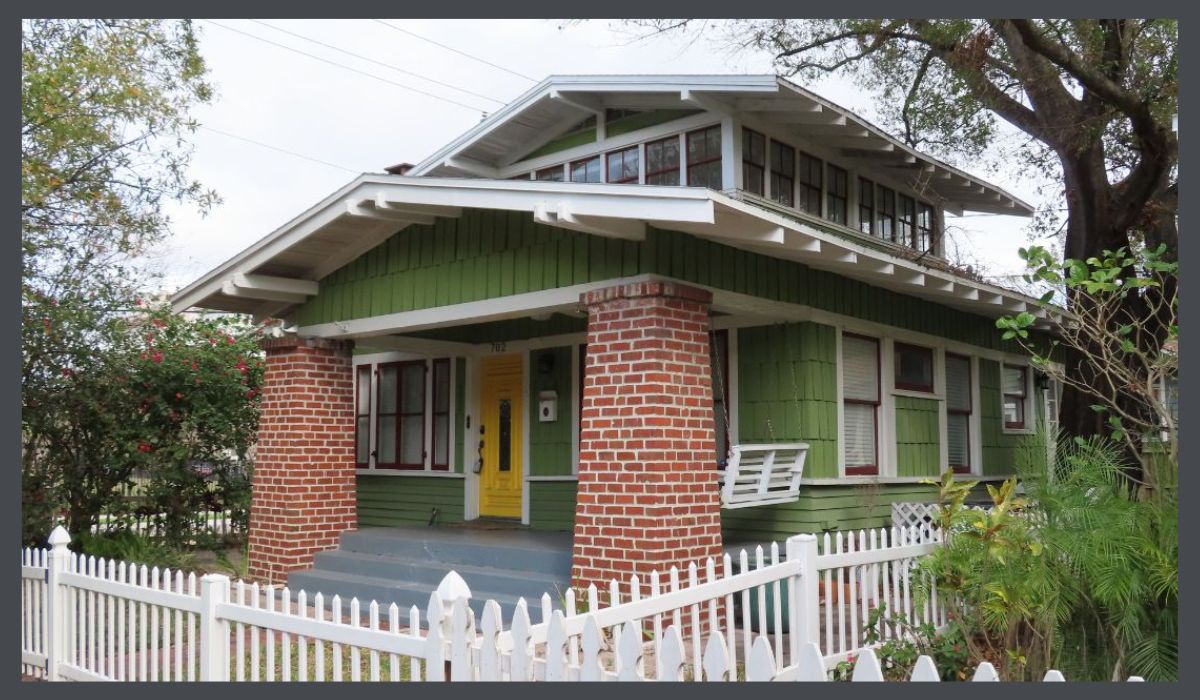
DESCRIPTION OF CHARACTERISTICS
Here’s an airplane bungalow gem on our tour of Bungalow Terrace, in Hyde Park, Tampa Florida. You can see the care that went into designing this court by the use of multiple materials- stout red brick columns, use of both shingles & lap siding, paired outriggers, and multiple window styles.
Though the first ones in the court were built in 1913, the records show that this one was not built until 1939.
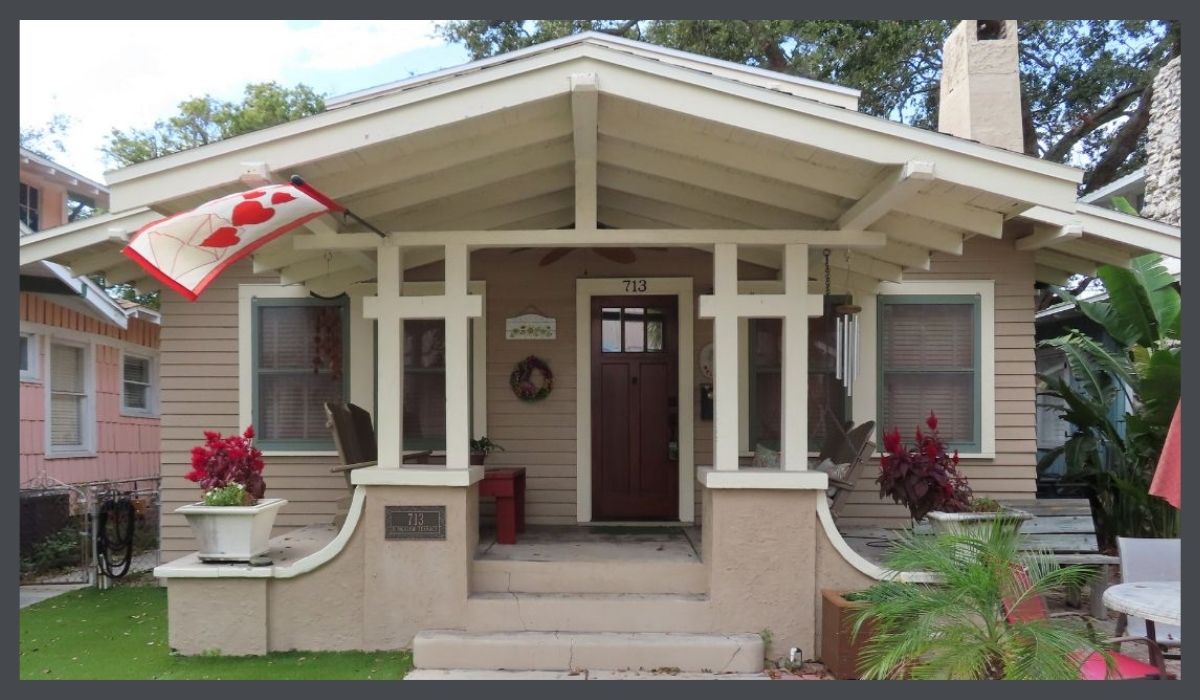
DESCRIPTION OF CHARACTERISTICS
I have a huge weakness for unusual columns, particularly when paired with such a large overhang. I do love chunky ones, but I especially like it that the developer of this bungalow court in Tampa, Florida took a few minutes to say, “Let’s not make little houses that look all the same,” half a century before Pete Seeger sang about suburban houses made of tick-tacky.
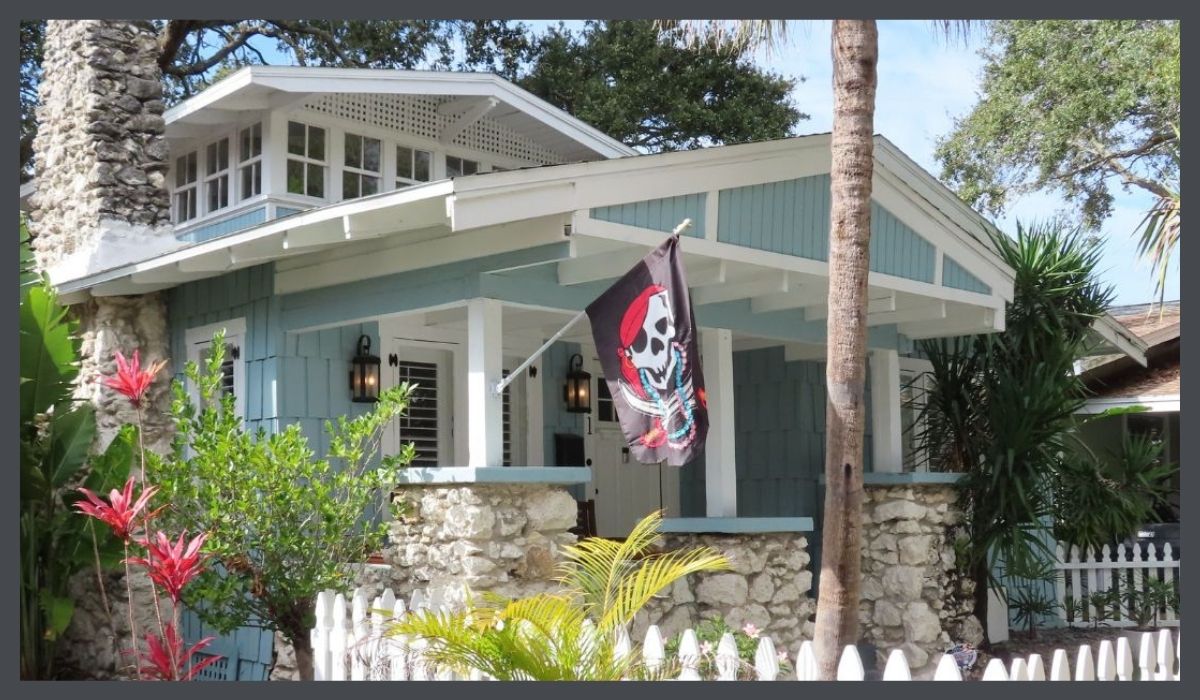
DESCRIPTION OF CHARACTERISTICS
This cute little airplane bungalow, features a sleeping porch with a 360 degree panoramic view, shingle siding (unfortunately painted) & limerock columns & a big honkin’ stone chimney!
Its lot size is 38×63 & the house itself, with 2 bedrooms & 2 baths & the house is 1,360 sq ft. Small but packed with great architectural features!
Go Bucs!

DESCRIPTION OF CHARACTERISTICS
Once again, the original developers used some great detail in this smaller (1,236 sq. ft.) airplane bungalow home in Bungalow Terrace in Hyde Park, Tampa, Florida. The bold paint job emphasizes the structural elements of the roof overhang.
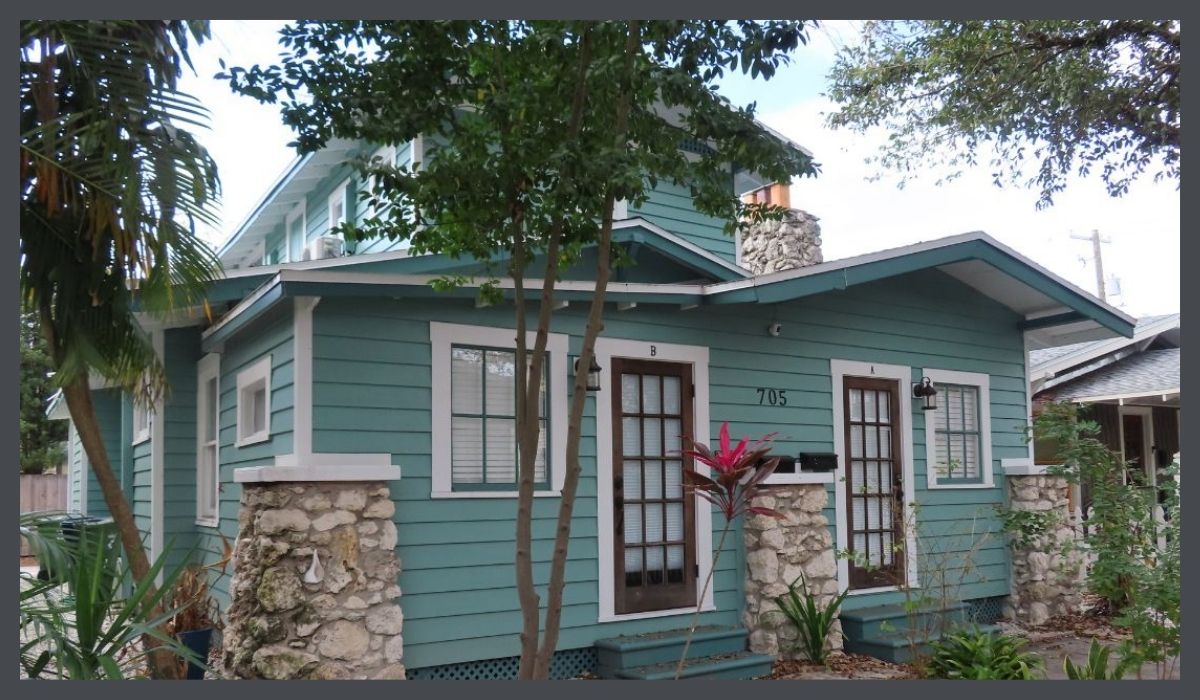
DESCRIPTION OF CHARACTERISTICS
A bungalow court triplex converted from a single family home, in Bungalow Terrace, Hyde Park, Tampa, Florida.
Built in 1916, like several of the others, it has a pop-up sleeping porch & wonderful stone columns & chimney. Unfortunately, what appears to have originally been an open porch has been closed in.
Once again, the original developers used some great detail in this smaller (1,236 sq. ft.) airplane bungalow home in Bungalow Terrace. The bold paint job emphasizes the structural elements of the roof overhang.

DESCRIPTION OF CHARACTERISTICS
This is another of the delightful homes in the Hyde Park Bungalow Terrace neighborhood. The composition of the front facade is wonderfully balanced with multiple front facing gables that pull the eyes from shape to shape & detail to detail.
Developed over several decades, the neighborhood of Hyde Park in which the court is located, was built as an upscale district with a variety of architectural styles. Today it is a beautiful example of how historic preservation can benefit a community, financially, aesthetically & culturally.
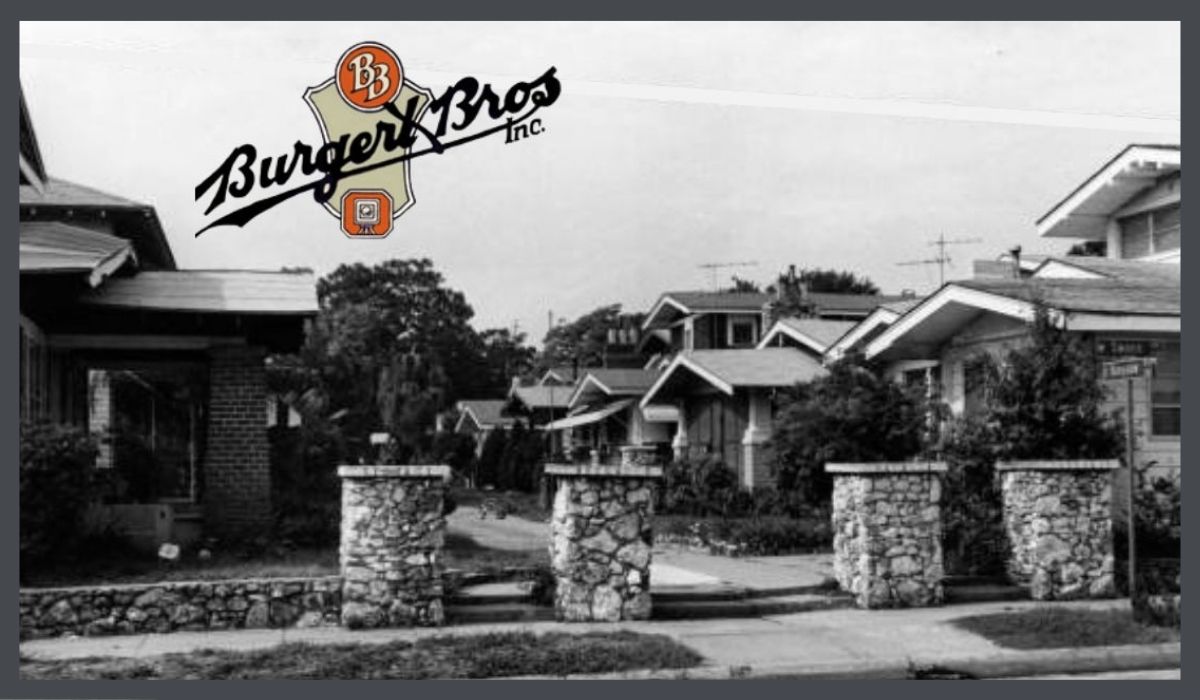
BUNGALOW TERRACE LONG AGO
Burgert Brothers was Tampa’s leading commercial photographic firm from 1917 to the early 1960s. Established by brothers Al & Jean, the studio focused primarily on photographing the Tampa Bay & surrounding areas. We are indeed fortunate to have the Burgert Brothers’ photographs which tell the tale of Tampa’s development from small town to major city. I made good use of them in the film I produced for my Tampa bungalow neighborhood.
I hope that you have the opportunity to visit this charming community, looking very much like the historic image above, yourself some day.
TIP: To learn more about the value of preservation, visit my page HERE!
 STAY IN THE BUNGALOW KNOW!!!
STAY IN THE BUNGALOW KNOW!!!
Sign up for our newsletter & receive our FREE E-book, 7 VITAL Things to Do Before You Hire a Contractor.
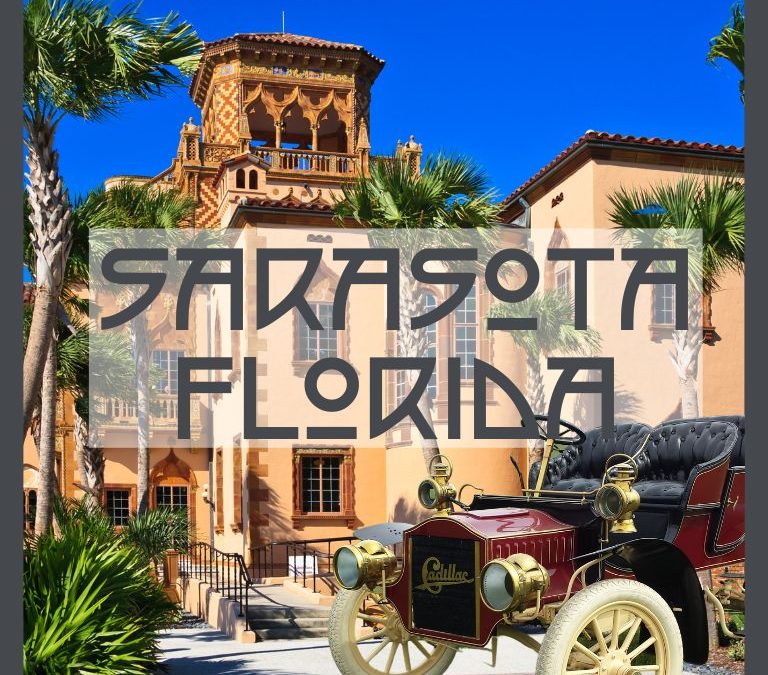
by bungalow101 | Jan 29, 2023 | Places to visit
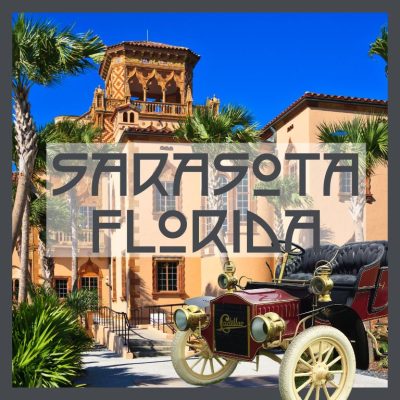 Let me warn you that Sarasota, in addition to being home to some of the finest museums & house museums & gardens in the United States, is well-populated with an abundance of the best antique stores in the country. I have made many happy purchases there! (Hubby says, “Too many!” but really, what does he know?)
Let me warn you that Sarasota, in addition to being home to some of the finest museums & house museums & gardens in the United States, is well-populated with an abundance of the best antique stores in the country. I have made many happy purchases there! (Hubby says, “Too many!” but really, what does he know?)
Some town history- in 1763, the area was dubbed, probably by the Spaniards, as “Zarazote.” The town was incorporated in 1902 & then as a city around 10 years later. There is a definite ambiance of age everywhere you go in the city.
When I want to expand my Florida house museum experiences outside Tampa Bay, it is a delightful day trip. If you are taking the kids (or yourself) to Disney in Orlando, it is just over 2 hours. But check Google Maps. There’s almost some bit of construction slowing things down to a crawl.
If you want to make a longer trip of it, you can lie on Sarasota’s white sand beaches. Visit the Mote Marine Laboratory & Aquarium with more than 100 species of marine animals. Touch a stingray. Their shark tank is enormous with over 100,000 gallons of water!
For those of you who prefer mammals, there’s also Big Cat Habitat where you can do yoga with tigers.
BUT I GO TO SARASOTA FOR THE HOUSE MUSEUM!
And well, yeah, the antique shops. So, let’s hop in the old Caddy & go.
THE RINGLING
The Ringling is a 66-acre complex of attractions, each one extraordinary in its own right. I’ll start with the Museum of Art. Completed in 1930 as a gift to the people of Florida, Ringling, an avid collector of art, sought to widen the knowledge & curiosity of the wider world. Please read the history of the museum on its page on the site so that you can understand the true magnificence of this gift.
Walking through the courtyard that joins the galleries you are transported to a world in which beauty reigns supreme & you get a glimpse into the genius & sheer vitality of Ringling.
Circus Museum
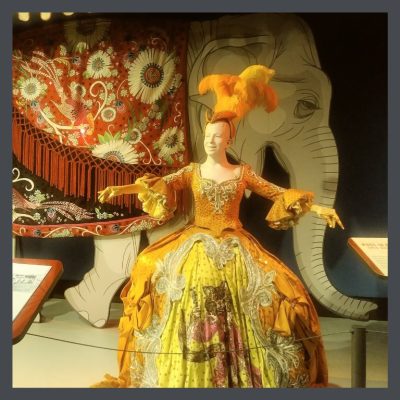 In 1927, Ringling made Sarasota his winter headquarters & many performers relocated there, generously donating costumes & other memorabilia from the earliest years of the circus here. Again, view the website for images of the museum displays. There you are transported to an era when the circus announced its coming with colorful posters & when the train arrived, gathered the town for a circus parade down Main Street complete with a brass band, elephants blanketed in spangles & bejeweled carriages pulled by horses wearing headdresses.
In 1927, Ringling made Sarasota his winter headquarters & many performers relocated there, generously donating costumes & other memorabilia from the earliest years of the circus here. Again, view the website for images of the museum displays. There you are transported to an era when the circus announced its coming with colorful posters & when the train arrived, gathered the town for a circus parade down Main Street complete with a brass band, elephants blanketed in spangles & bejeweled carriages pulled by horses wearing headdresses.
As a child, until I attended school, I wore only costumes, refusing to appear in regular clothing. I was a ballerina, a mermaid, a bride, a tightrope walker, draped with all sorts of ornamentation that my dear mother cheerfully provided for her imaginative daughter.
In this museum I saw what my little girl self had so clearly imagined when she adorned herself in her mother’s cast-offs- hoop skirts & sparkles & tassels & feathers & tutus & shoes that laced to the knee. After hearing my mother’s stories of her own childhood in the early 20’s, seeing these colorful, period items were a fantasy come true.
You can also see a real circus wagon complete with calliope that was used in the parade when they arrived in town to invite everyone to come to the Big Top!
Wait, there’s more. There’s a miniature circus complete with the circus train that runs through old towns to arrive at its destination. You see tiny people who set up the tents, the bleachers, the mess area. Again, the early world of my mother tales which made it all the more wonderful for me.
Please let me know about your visits to the museum in the comment section below. I hope it touches you as it did me.
Ca’ d”Zan
(House of John)
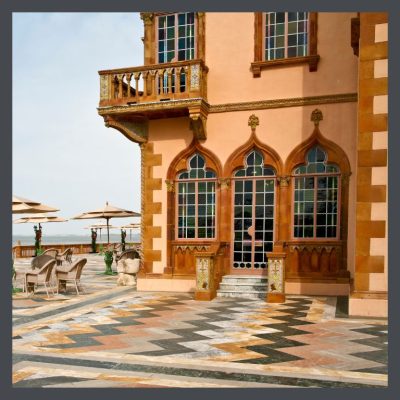 That’s the Venetian. In Italian, it would be Casa di Giovanni. Much less exotic, they made the right choice!
That’s the Venetian. In Italian, it would be Casa di Giovanni. Much less exotic, they made the right choice!
Ca’ d”Zan is John & Mable Ringling’s 36,000 square foot home, modeled on the great architecture of Venice. It displays a number of architectural styles, including that of Venice, Italy, Spain & the Moors from different historic periods. The Venetian Gothic influence predominates. The style is likely to have originated in the 13th Century & experienced a revival in the 19th Century inspired by the writings of my buddy, John Ruskin whose quote about the nature of the home introduces the blog.
As amazing as the architecture & interior features are, the furniture & décor are astonishing in their beauty & opulence. The Ringling’s were world travelers & collectors & every piece was chosen to enhance the beauty of the house.
I am not a big fan of displays of wealth, but I have to admit that house museums, from modest settler houses to grand mansions are my favorite places to visit. Again, look at the website to see images of this amazing house but realize, it doesn’t compare with what will what you will experience gazing at the ceiling of any one room.
Bayfront Gardens
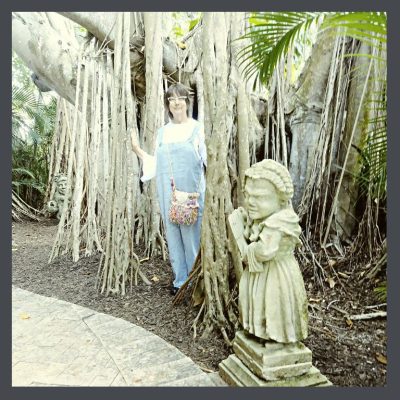 This garden, completed in 1913 under the watchful eye of Mable Ringling, has everything I love, rose gardens, banyans & a Dwarf Garden. My mother & grandmother grew roses & you already know how I feel about them! I love banyan trees because they are so Florida & so ancient. Though native to India & Pakistan, they escaped cultivation & in all of North America, they grow only in this state. Their branches grow roots that grow down into the soil & these roots can become as large as trunks, making a single tree look like a thicket.
This garden, completed in 1913 under the watchful eye of Mable Ringling, has everything I love, rose gardens, banyans & a Dwarf Garden. My mother & grandmother grew roses & you already know how I feel about them! I love banyan trees because they are so Florida & so ancient. Though native to India & Pakistan, they escaped cultivation & in all of North America, they grow only in this state. Their branches grow roots that grow down into the soil & these roots can become as large as trunks, making a single tree look like a thicket.
Here I am in my favorite overalls, having a lovely respite in the garden after a day of being bedazzled by the museum. The statuary is extremely lifelike & adds an intriguing bit of life to the gardens.
Historic Asolo Theatre
By the time I made my way to the theatre, I was completely exhausted! So, just see what the website has to say about it.
Please let me know about your experiences in these places that are so dear to me. Feel free to comment below!
TIP: Visit my article about other wonderful historic places in Florida to visit HERE.
 STAY IN THE BUNGALOW KNOW!!!
STAY IN THE BUNGALOW KNOW!!!
Sign up for our newsletter & receive our FREE E-book, 7 VITAL Things to Do Before You Hire a Contractor.
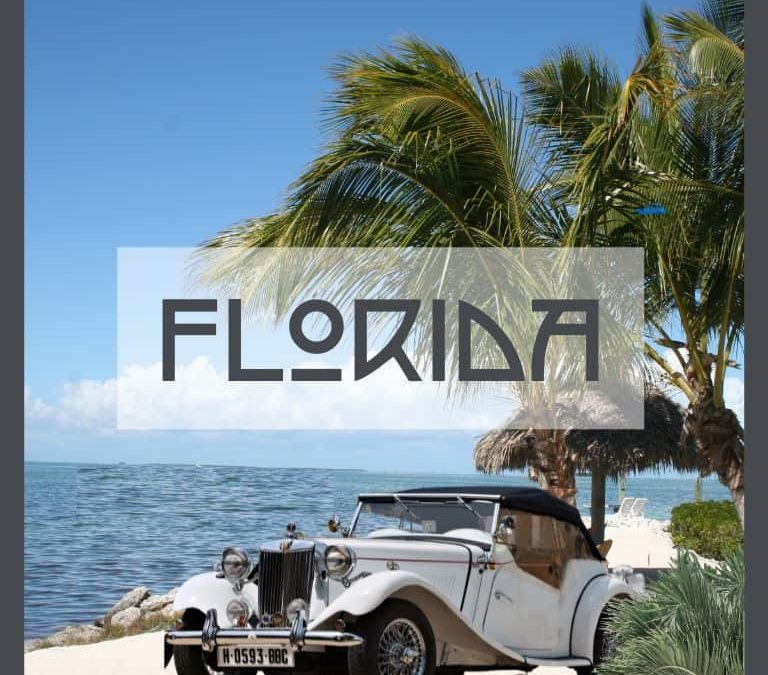
by bungalow101 | Nov 29, 2022 | Places to visit
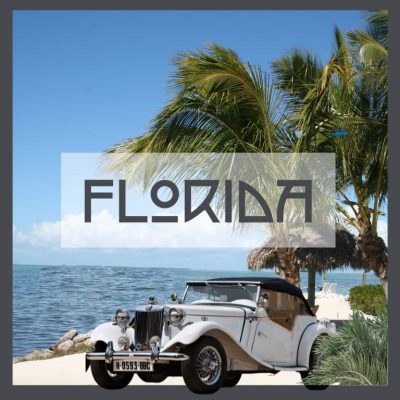 Florida’s history museums & historic museum houses tell a 3D tale of the state & the land boom of the 20’s that cannot be fully expressed in any book, though I have to admit that I did a pretty good job in the historic documenatry film I produced!
Florida’s history museums & historic museum houses tell a 3D tale of the state & the land boom of the 20’s that cannot be fully expressed in any book, though I have to admit that I did a pretty good job in the historic documenatry film I produced!
The financial momentum of the times was astonomical! I am not trying to lure you away from my blog, but this page clearly explains the culture of the times. It is a fascinating & enlightening read.
Welcome back!
A great many of these homes were bungalows, a style not too different from the houses built by the early settlers, with deep porches, prominent overhangs & an abundance of large windows. After several years of coaxing, American Bungalow Magazine came to Florida & featured homes in 4 neighborhoods in the central part of the state. You can read about them on my Instagram page.
DUNEDIN
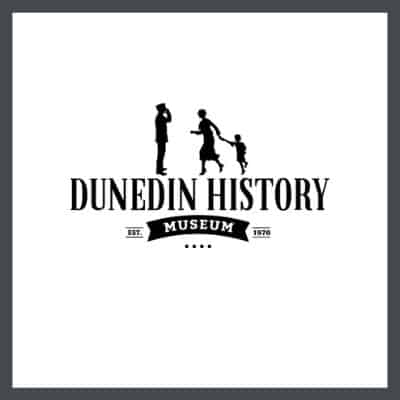 Dunedin History Museum
Dunedin History Museum
“Where History Comes Alive”
I love this friendly, quirky little museum. The last exhibit we saw there was “Jagged Lines: America’s Tattoo Tradition,” focusing on the evolution of tattoo art.
The Museum collections contains approximately 2,000 artifacts, 2,500 photographs, & a library of 200 volumes of local & State history. Their permanent exhibits feature statewide topics such as the railroad & citrus industries, but the best ones are regional topics such as Dunedin’s multicultural origins, pioneering families, & even the story of the development of the alligator tank used by the U.S. Marines during WWII in the Pacific.
LARGO
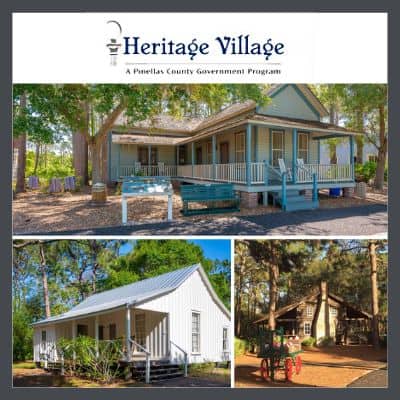 Heritage Village
Heritage Village
Explore this 21-acre living history museum located in its natural pine and palmetto landscape. Included amongst the structures & exhibits is the Turner House, built in 1915, of the Florida vernacular bungalow style of that time period.
The house was bequeathed to the County, along with $100,000 in moving costs & the contents of the 1915 bungalow. Now let me explain when I say contents- 6 pages of documented items, including: “furniture, accessory items, lighting, artwork, mirrors, wall pieces, toys, school memorabilia, linens, clothing, shoes, hats, costume jewelry, kitchen furnishings, tableware, cameras, clocks, radios, fans, china sets, glassware, serving pieces, decorative glass, pottery, vases, figurines, Belleview Biltmore items, sporting goods & more.
Some of the notable items include an 1860 quilt, silver plate flatware set from 1921, state license plates from 1949-1953, a child’s pedal car from 1933 and a 1940 Clearwater High School class ring.”
These items are on display at the museum of the grounds & sweep you into the life of this family whose story is told in photos, maps & sign around the museum. The house is not yet open, needing much work to make it safe, so stop by & pitch in a nice donation so that you’ll be able to actually tour the house in the future.
TAMPA
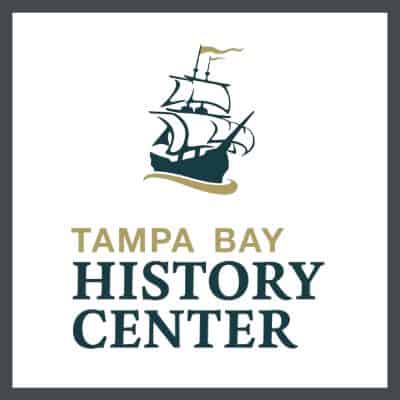 Tampa Bay History Center
Tampa Bay History Center
A Smithsonian Affiliate museum, the History Center includes three floors of permanent and temporary exhibition galleries in 60,000 square feet, focusing on 12,000 years of Florida’s history, heritage & culture, focusing on Tampa Bay.
It offers many permanent & changing exhibits as well as activities in which you can learn about the area, including:
Docent-guided walking tours of Tampa’s historic sites and neighborhoods,
A monthly book group focused on Florida literature. The event is free with registration,
Florida Conversations is a free, monthly lecture series highlighting research into Florida history,
As well as many activities for children & teens.
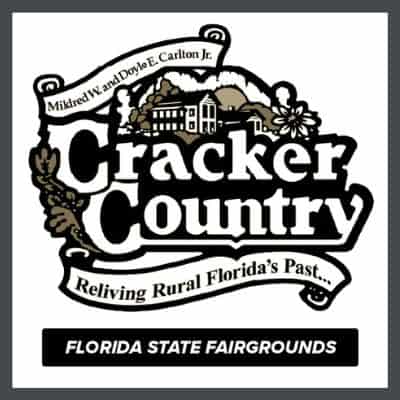 Cracker Country
Cracker Country
I discovered Cracker Country, a living history museum of old rural buildings from the late 19th Century, which were relocated to the Florida State Fairgrounds when we had come to see the fair, but I was much more interested in the old buildings & demonstrations of early settler skills than in rollercoaster rides. (Well, not really. I was there for the gardening displays, the crafts & the corn dogs.)
The key features of living in Florida are the heat & humidity & the resultant awful creatures. The homes of Cracker Country display great ingenuity of design in creating dwellings in which people could experience some degree of comfort through shade, ventilation & elevation.
You can see the bungalow in these early designs. Our homes here in Florida, tend to have large porches, & deep overhangs, tall windows & lots of ‘em!
Ybor City Museum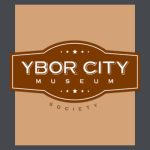
In 1886, when Tampa was mostly pine scrub. cigar manufacturer & entrepreneur Don Vicente Martinez Ybor came from Cuba via Key West to found Ybor City, the “Cigar Capital of the World.” This museum, housed in the historic Ferliia Bakery, (built by another old Tampa family in 1923 after the original building from 1835 was destroyed by fire) & urban park are dedicated to the preservation of Ybor City’s unique cultural heritage.
In addition to their great collection of artifacts, you can often see demonstrations of cigar rolling but the very best part is the film about the area which sweeps you back to the birth of historic of Ybor City.
TARPON SPRINGS
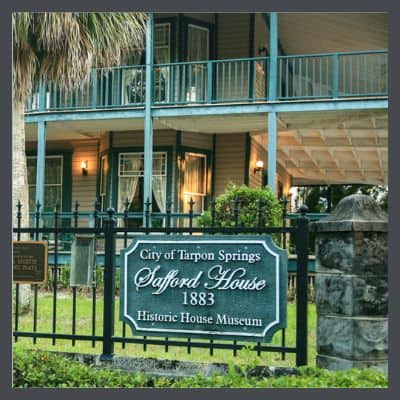 The Safford House Museum
The Safford House Museum
Although the main draw in Tarpon is the sponge docks & commercial/tourist area, I enjoy trotting around the historic downtown area & driving through the old residential areas built in the late 1800- early 1900’s.
A great attraction is the 1883 Safford House Museum, restored to its original Victorian splendor, which was the home of one of the city’s original developers. Listed on the National Register of Historic Places, the house is a fine example of late 19th century Florida vernacular architecture, & complete with period furnishings & family possessions, it provides the full flavor of upper-class living in the state as it was developing.
Take the opportunity to visit Florida’s history museums & historic museum houses. It’s the only way to discover the true flavor of the Sunshine State.
If you’re a local, all these museums & homes need your volunteer skills. Your participation will provide you with a great learning experience & reward you with warm friends as mine did.
TIP: Read my article about the wonderful historic places to visit in Sarasota HERE.
 STAY IN THE BUNGALOW KNOW!!!
STAY IN THE BUNGALOW KNOW!!!
Sign up for our newsletter & receive our FREE E-book, 7 VITAL Things to Do Before You Hire a Contractor.

 INSCRIPTION:
INSCRIPTION:







 STAY IN THE BUNGALOW KNOW!!!
STAY IN THE BUNGALOW KNOW!!!


 Let me warn you that Sarasota, in addition to being home to some of the finest museums & house museums & gardens in the United States, is well-populated with an abundance of the best antique stores in the country. I have made many happy purchases there! (Hubby says, “Too many!” but really, what does he know?)
Let me warn you that Sarasota, in addition to being home to some of the finest museums & house museums & gardens in the United States, is well-populated with an abundance of the best antique stores in the country. I have made many happy purchases there! (Hubby says, “Too many!” but really, what does he know?) In 1927, Ringling made Sarasota his winter headquarters & many performers relocated there, generously donating costumes & other memorabilia from the earliest years of the circus here. Again, view the website for images of the museum displays. There you are transported to an era when the circus announced its coming with colorful posters & when the train arrived, gathered the town for a circus parade down Main Street complete with a brass band, elephants blanketed in spangles & bejeweled carriages pulled by horses wearing headdresses.
In 1927, Ringling made Sarasota his winter headquarters & many performers relocated there, generously donating costumes & other memorabilia from the earliest years of the circus here. Again, view the website for images of the museum displays. There you are transported to an era when the circus announced its coming with colorful posters & when the train arrived, gathered the town for a circus parade down Main Street complete with a brass band, elephants blanketed in spangles & bejeweled carriages pulled by horses wearing headdresses. That’s the Venetian. In Italian, it would be Casa di Giovanni. Much less exotic, they made the right choice!
That’s the Venetian. In Italian, it would be Casa di Giovanni. Much less exotic, they made the right choice! This garden, completed in 1913 under the watchful eye of Mable Ringling, has everything I love, rose gardens, banyans & a Dwarf Garden. My mother & grandmother grew roses & you already know how I feel about them! I love banyan trees because they are so Florida & so ancient. Though native to India & Pakistan, they escaped cultivation & in all of North America, they grow only in this state. Their branches grow roots that grow down into the soil & these roots can become as large as trunks, making a single tree look like a thicket.
This garden, completed in 1913 under the watchful eye of Mable Ringling, has everything I love, rose gardens, banyans & a Dwarf Garden. My mother & grandmother grew roses & you already know how I feel about them! I love banyan trees because they are so Florida & so ancient. Though native to India & Pakistan, they escaped cultivation & in all of North America, they grow only in this state. Their branches grow roots that grow down into the soil & these roots can become as large as trunks, making a single tree look like a thicket.

 Florida’s history museums & historic museum houses tell a 3D tale of the state & the land boom of the 20’s that cannot be fully expressed in any book, though I have to admit that I did a pretty good job in the
Florida’s history museums & historic museum houses tell a 3D tale of the state & the land boom of the 20’s that cannot be fully expressed in any book, though I have to admit that I did a pretty good job in the 




